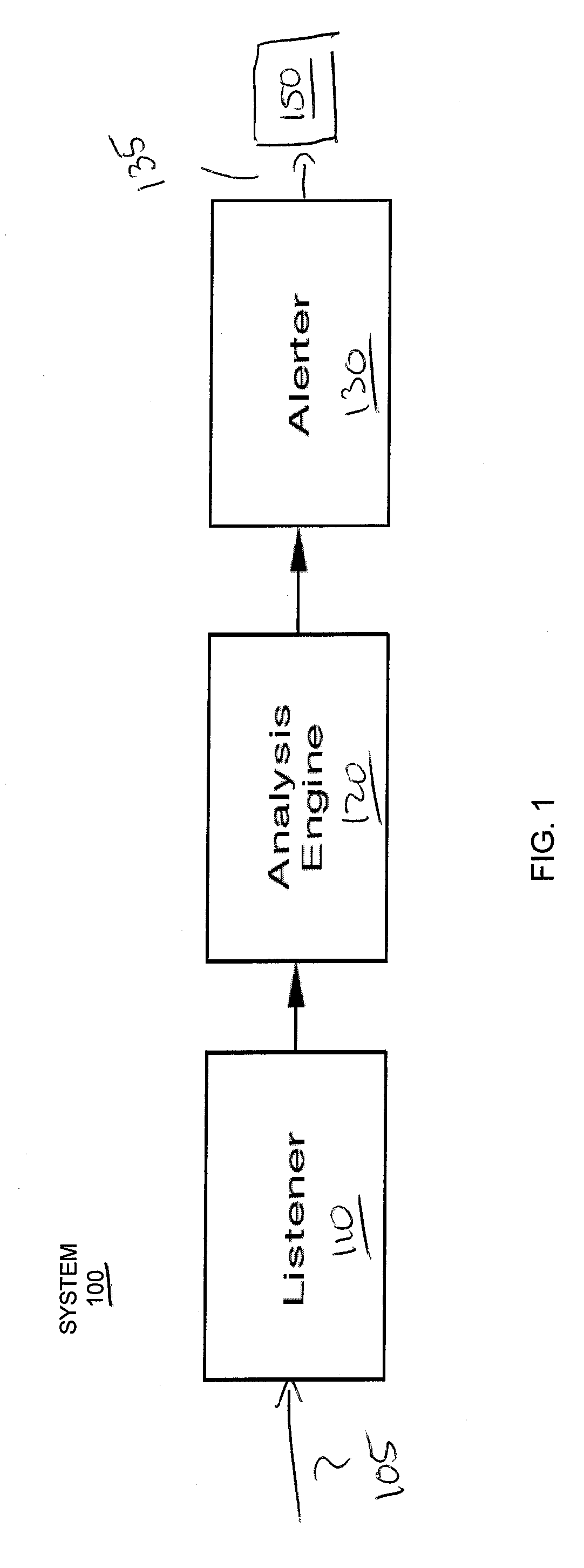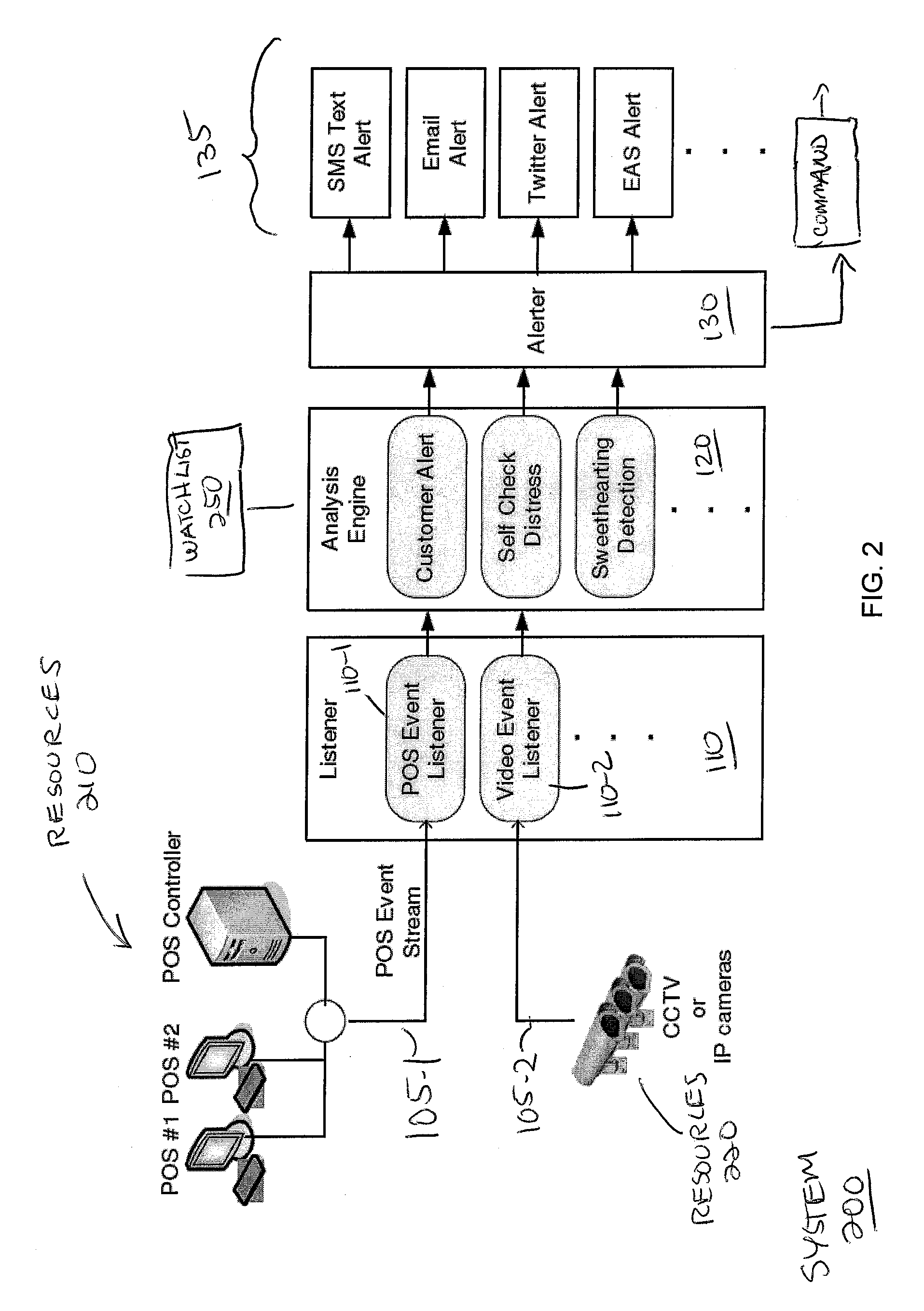Notification system and methods for use in retail environments
a technology for notifying systems and retail environments, applied in the direction of burglar alarms, mechanical actuation of burglar alarms, burglar alarms by hand-portable objects removal, etc., can solve problems such as scanning systems being susceptible to “pass-throughs”, scanners suffering from a variety of deficiencies, and affecting the operation of such systems
- Summary
- Abstract
- Description
- Claims
- Application Information
AI Technical Summary
Benefits of technology
Problems solved by technology
Method used
Image
Examples
embodiment # 1
Embodiment #1
[0050]In one embodiment, the analysis engine 120 is capable of looking for a variety of AOIs. For instance, the analysis engine 120 can be configured to retrieve and / or analyze specific types of data in the data feeds 105 to detect customer identifier information. For example, transaction data from one or more feed can include transaction log information (e.g., point of sale data) indicating the items scanned a terminal. The transaction data from one or more feeds 105 also can include images of the transaction as captured by monitor devices. In accordance with one embodiment, based on customer identifier information (e.g., in or derived from the one or more different types of feeds 105), the analysis engine 120 is able to detect when particular customers of interest are shopping in a respective retail environment.
[0051]In accordance with further embodiments, unique information to identify a customer can be found within the feeds 105 themselves. In such an inst...
embodiment # 2
Embodiment #2
Multi-Stage Alert Processing
[0069]In accordance with one embodiment, the system 100 monitors data generated in a retail environment. Based on an analysis of the data, the system 100 identifies the occurrence of a trigger event associated with a sales transaction in the retail environment. The system 100 produces a preliminary alert based on the occurrence of the trigger event, condition, etc. There may be a degree of uncertainty that the trigger event, condition, etc., occurred because the analysis engine 120 may be inaccurate. The system 100 transmits the preliminary alert to a remote processor for validation. The remote processor can include a human reviewer that produces the validation of the preliminary alert. In response to validation of the preliminary alert by the remote processor, the system 100 produces and transmits a notification to one or more target destinations located internal or external with respect to the retail environment. The notification can includ...
embodiment # 3
Embodiment #3
Cart Pushouts
[0093]In yet further embodiments, the analysis engine 120 can be configured to monitor received data feeds to identify occurrence of events such as cart push-out events. As an example, a cart-pushout event refers to an event in which a respective customer pushing a shopping cart leaves (or attempts to leave) a retail environment without paying for one or more present in the shopping cart.
[0094]Applicants note that shopping cart as discussed herein refers any type of resource (e.g., basket, container, bag, etc.) to convey one or more retail items around and / or out of the retail environment.
[0095]In accordance with such an embodiment, the system 100 monitors a shopping cart in a retail environment. Assume that the system 100 detects presence of the shopping cart in a predetermined area in the retail environment. Responsive to detecting presence of the shopping cart in the predetermined area in the retail environment, the system 100 generates a notification in...
PUM
 Login to View More
Login to View More Abstract
Description
Claims
Application Information
 Login to View More
Login to View More - R&D
- Intellectual Property
- Life Sciences
- Materials
- Tech Scout
- Unparalleled Data Quality
- Higher Quality Content
- 60% Fewer Hallucinations
Browse by: Latest US Patents, China's latest patents, Technical Efficacy Thesaurus, Application Domain, Technology Topic, Popular Technical Reports.
© 2025 PatSnap. All rights reserved.Legal|Privacy policy|Modern Slavery Act Transparency Statement|Sitemap|About US| Contact US: help@patsnap.com



